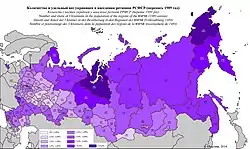Ukrainians in Siberia
Siberian Ukrainians (Ukrainian: Сибірські Українці, romanized: Sybirski Ukraintsi; Russian: Сибирские Украинцы, romanized: Sibirskiye Ukraintsy) form a national minority in Siberia and the Russian Far East, but make up the majority in some cities there. Siberian Ukrainians, one of the largest and historically important constituent parts of the Ukrainian diaspora, represent one of the first Ukrainian diasporas.
| Total population | |
|---|---|
| Unknown | |
| Regions with significant populations | |
| Norilsk, Magadan, Yakutia, Amur Oblast, Tyumen Oblast, Far North, Far East | |
| Languages | |
| Russian, Ukrainian, Surzhyk | |
| Religion | |
| Eastern Orthodox, Old Believers | |
| Related ethnic groups | |
| Ukrainians, Russians, other East Slavs |
History
Russian Empire
Two million Ukrainian peasants settled in Siberia between the 1600s and 1917. In the 19th century, the government of Russia encouraged peasants to move from the western parts of the empire to Siberia. Ukrainian peasants, not as burdened by the traditional Russian communal system of agriculture as the Russian peasants had been, seemed ideal candidates for resettlement, often more willing to go in return for the promise of more land. The literacy societies were among the few public service organizations in Tsarist Russia. The Khar’khov Society, while Russian-speaking, included many Ukrainians and was among the most active of such societies.[1]
Soviet era


Dekulakization
Kulaks and their families were deported.
World War II refugees
During Operation Barbarossa evacuations commenced of Russian, Belarusian and Ukrainian civilians from Europe over the Ural Mountains. These evacuees included skilled Russian and Jewish workers and professionals as well as nationally conscious members of the Ukrainian clergy and intelligentsia. The Soviets feared that the Nazis would exploit the ethno-national detachment of the educated and many were prohibited from returning to Ukraine after the war.[2]
Gulag
During the Stalin era, and especially after World War II many Ukrainians were sent to Gulag; some of them were former participants of the Ukrainian Insurgent Army. Ukrainians contributed to the Norilsk Uprising and other gulag uprisings in 1953. Many (but not all) Ukrainians living in Siberia and Russia are the descendants of prisoners.[3]
Modern Russia
After the collapse of the Soviet Union many Ukrainians chose to stay in Siberia, unlike many other nationalities. That combined with natural growth caused their share of the population to increase. However overall the population numbers declined due to assimilation.
Ukrainian exodus
In mid-2014, trains began to arrive in Siberia carrying Ukrainian refugees.[4] Many refugees and immigrants were welcomed by Siberian natives and many settled in predominantly indigenous areas.[5]
Many however, were unaware of their location upon their arrival, in one case, immigrants from Ukraine arriving in Magadan walked out of the plane confused - asking reporters where they were. Analysts assume Ukrainians are arriving in depopulated areas (i.e. Igarka) for the purpose of repopulation.[6]
Areas of settlement
Population
Large numbers of people with full or partial Ukrainian descent were born in Siberia and live there. Large numbers of immigrants also live in Siberia, while another large group includes illegal immigrants.
Notable Siberian Ukrainians
- Gennady Alferenko
- Anatoly Babko
- Konstantin Chernenko
- Valeria Ivanenko
- Tina Karol
- Vitali Kischenko
- Ilya Lagutenko
- Petro Oliynik
- Oleksandr Opanasenko
- Anastasia Prokopenko
- Oleg Sukhoruchenko
- Vladimir Tatarchuk
- Vitaly Teslenko
- Nikolai Usenko
- Aleksey Yakimenko
- Dmitri Yaroshenko
- Kostyantyn Zhevago
- Alexander Shlemenko
Ukrainian Culture in Siberia
There are several Ukrainian Language Newspapers in Siberia, as well as privately funded Ukrainian language schools.[7] The Ukrainian Catholic Church has Branches in many Siberian towns and villages that serve the immigrants from Western Ukraine[8]
References
- "Siberia and Migrants". 1892.
- Satzewich, Vic (2003). The Ukrainian Diaspora. Routledge. p. 88. ISBN 978-1-134-43495-4. Retrieved 3 June 2016.
- Harmon, Mike (22 July 2007). "The gulag uprising at Vorkuta, 1953". Libcom.org. Retrieved 2 June 2016.
- "Russia Flies Ukrainian Refugees to Safety…in Siberia". Vocativ. 2014. Retrieved 2 June 2016.
- Goble, Paul (27 October 2010). "Siberian nationalists seek alliance with ethnic Ukrainians in Far East". Kyivpost. Retrieved 2 June 2016.
- "Ukrainian Refugees to Repopulate Siberia". 2014-09-08.
- Nahaylo, Bohdan (1999). The Ukrainian Resurgence. C. Hurst & Co. Publishers. p. 7. ISBN 978-1-85065-168-0. Retrieved 3 June 2016.
- Evancilizationstation. "Ukrainian Greek Catholic Church".